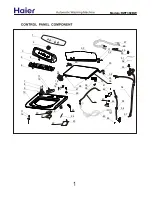
15
10. Connect inlet hoses to washer
IMPORTANT:
To reduce risk of hose failure, replace the
hoses every 5 years. Record hose installation or replacement
dates for future reference.
�
Do not overtighten hose or use tape or sealants on the
valve. Damage to the valves can result.
�
Periodically inspect and replace hoses if bulges, kinks,
cuts, wear, or leaks are found.
Attach hot water hose to hot water inlet valve. Screw
coupling by hand until it is snug. Use adjustable pliers to
tighten couplings an additional two-thirds turn. Repeat with
cold water inlet valve.
11. Check for leaks
Slowly turn on water faucets to check for leaks. A small
amount of water may enter washer. It will drain later.
12. Secure drain hose
Secure drain hose to laundry tub leg, drain standpipe, or inlet
hoses for wall standpipe with cable tie or beaded tie strap.
It is the responsibility of the installer to install and secure the
drain hose in to the provided plumbing/drain in a manner that
will avoid the drain hose coming out of or leaking from the
plumbing/drain.
Level Washer
IMPORTANT:
Leveling your washer properly reduces excess
noise and vibration.
13. Check levelness of washer
Remove cardboard from beneath washer. Place a level on
top edges of washer, checking each side and front. If not
level, tip washer and adjust feet up or down as shown in
steps 15 and 16, repeating as necessary.
14. Rock washer to test foot contact
Grip washer from top and rock back and forth, making sure
all four feet are firmly on floor. Repeat, rocking washer from
side to side. If washer rocks, go to step 15 and adjust leveling
feet. If all four feet are in firm contact with floor, go to step 16.
















































